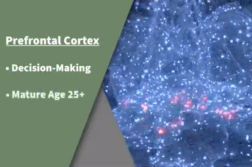ST. LOUIS, Mo. (Ivanhoe Newswire) – Every 40 seconds in the U.S., someone has a stroke. But not all strokes happen to older people – up to 15 percent of strokes happen to people under age 45. In fact, some people are actually born with something called AVM, and once it ruptures, it can be life-altering, even fatal.
Krysta Owings was 25, living her dream – working full-time in an equestrian barn – until one morning, something strange happened.
“I woke up and started having, you know, some blurry vision, little bit of balance issues,” she recalls.
In the ER, doctors diagnosed her with a ruptured AVM in her frontal lobe.
Neurosurgeon at Washington University in St. Louis, Dr. Gregory Zipfel, explains, “It’s a tangle of blood vessels that you’re born with. Most people have it for many, many years, often for a few decades before they find out about it.”
Dr. Zipfel says AVMs are rare and symptoms can be stroke-like, others can cause seizures, some never cause any problems at all and are found during routine scans.
“We want to get it treated, and treated pretty quickly so it can’t rupture again,” he adds.
Dr. Zipfel was able to remove part of Krysta’s skull. And using a high-powered microscope, he was able to seal off the AVM with special clips, and then remove it from surrounding brain tissue. Right after surgery, Krysta still suffered from the same symptoms.
“I couldn’t use anything on my left side of my body. I couldn’t walk, I couldn’t tell time,” Krysta tells Ivanhoe.
But that did change – it took three months before Krysta was ready to get back on a horse, but she knew her buddy Swiper would not let her down.
“He’ll just take care of you. He’s very intuitive, you know, he’ll listen to you,” Krysta says about her horse.
Dr. Zipfel says 10 percent of patients who have an AVM rupture will die. Of those who survive, up to 30 percent will have long-term neurological problems due to where in the brain the rupture happened.
Contributors to this news report include: Marsha Lewis, Producer; Roque Correa, Videographer & Editor.
To receive a free weekly e-mail on medical breakthroughs from Ivanhoe, sign up at: http://www.ivanhoe.com/ftk
Sources:
https://www.cdc.gov/stroke/facts.htm
MEDICAL BREAKTHROUGHS
RESEARCH SUMMARY
TOPIC: BORN WITH AVM: A SILENT KILLER OF YOUNG PEOPLE
REPORT: MB #5257
BACKGROUND: AVM stands for Arteriovenous Malformations, and these occur when a cluster of arteries and veins tangle within each other. When this happens, those blood vessels form direct connections – creating a sort of “detour” around the normal tissue. This malformation typically happens during fetal development or promptly following birth. The occurrence of a brain AVM happens in less than 1% of the population. AVMs are rare, with about 3000 new cases diagnosed in the U.S. every year. Typically, it’s the rupturing of one of the blood vessels that illuminates the seemingly dormant condition. However, approximately 12% of people with AVMs do experience symptoms.
(Sources: Arteriovenous Malformations | Johns Hopkins Medicine
What is an Arteriovenous Malformation | American Stroke Association
Arteriovenous Malformation (AVM) | Penn Medicine)
DIAGNOSING: The symptoms of AVM differ depending on the size and placement of the cluster in the body. Some individuals don’t experience symptoms until their mid-30s. For women, pregnancy may expose symptoms for the first time or worsen them. This is due to the increased pressure on the blood vessels during that time. To properly diagnose an AVM, your doctor may order a CT scan or an MRI of the head, spine, and neck to closely assess your blood vessels. Your doctor might also use a stethoscope to listen for “bruit” – a loud rush of blood flow into your blood vessels sometimes caused by AVM.
(Source: Arteriovenous Malformation (AVM) | Penn Medicine)
NEW TECHNOLOGY: Mayo Clinic has an extensive supply of treatment options for differing AVMs including stereotactic radiosurgery, microsurgical resection, and endovascular embolization. For AVMs of a small magnitude, glue embolization is offered as a way of treatment and bypasses the need for surgery.
(Source: AVMs: Advanced technology and expertise for complex pathology – Mayo Clinic)
FOR MORE INFORMATION ON THIS REPORT, PLEASE CONTACT:
Judy Martin Finch
If this story or any other Ivanhoe story has impacted your life or prompted you or someone you know to seek or change treatments, please let us know by contacting Marjorie Bekaert Thomas at mthomas@ivanhoe.com




